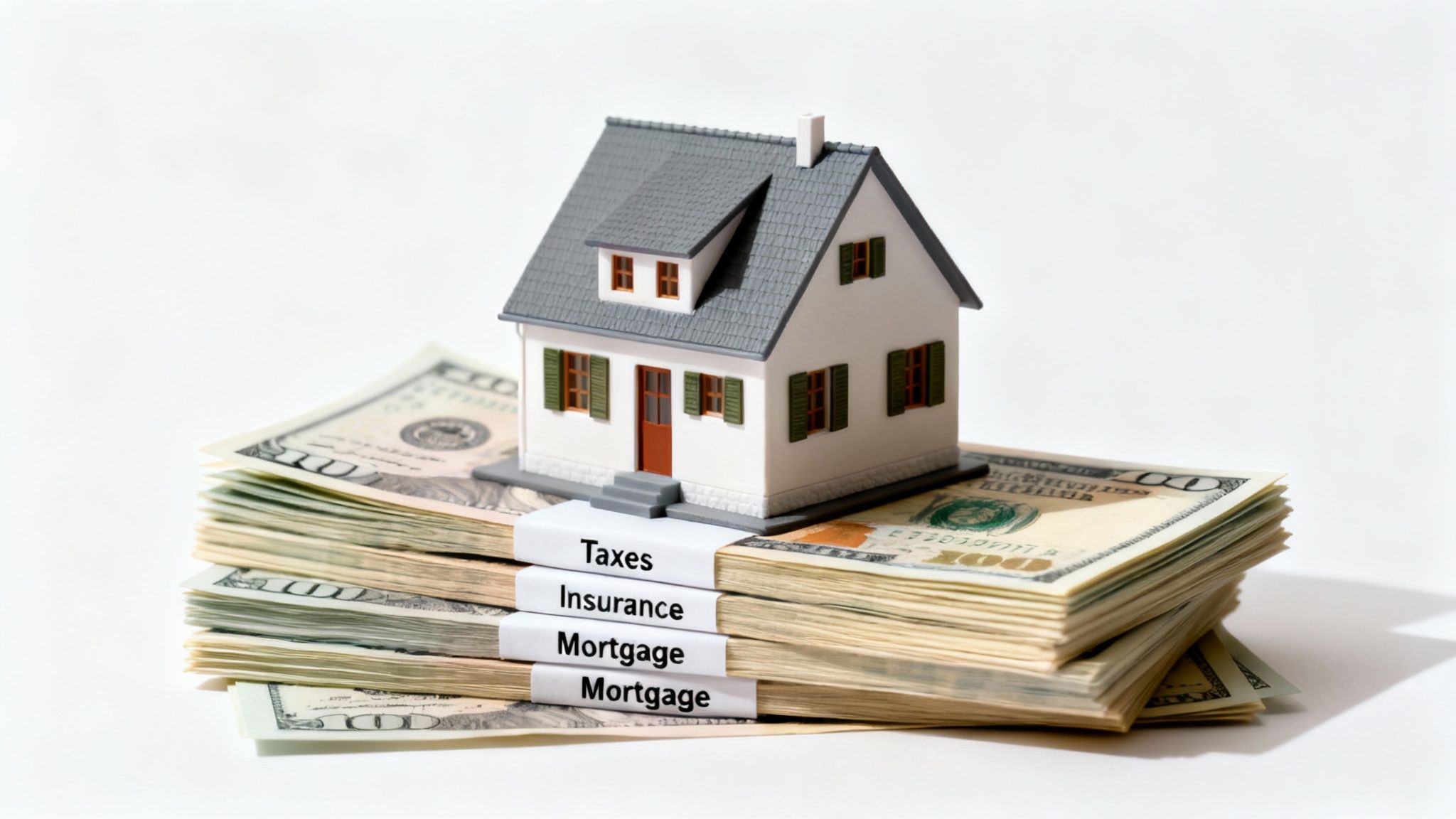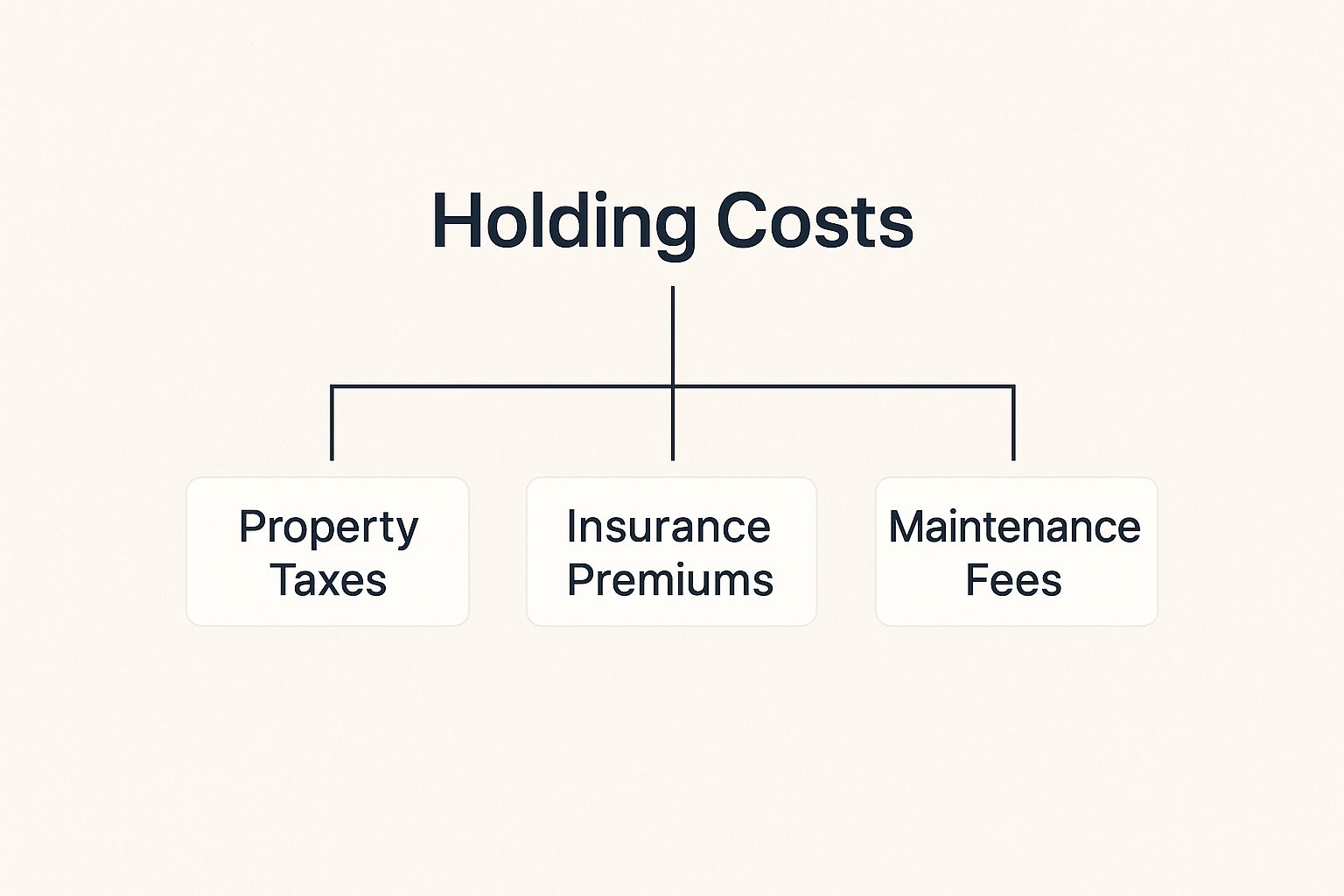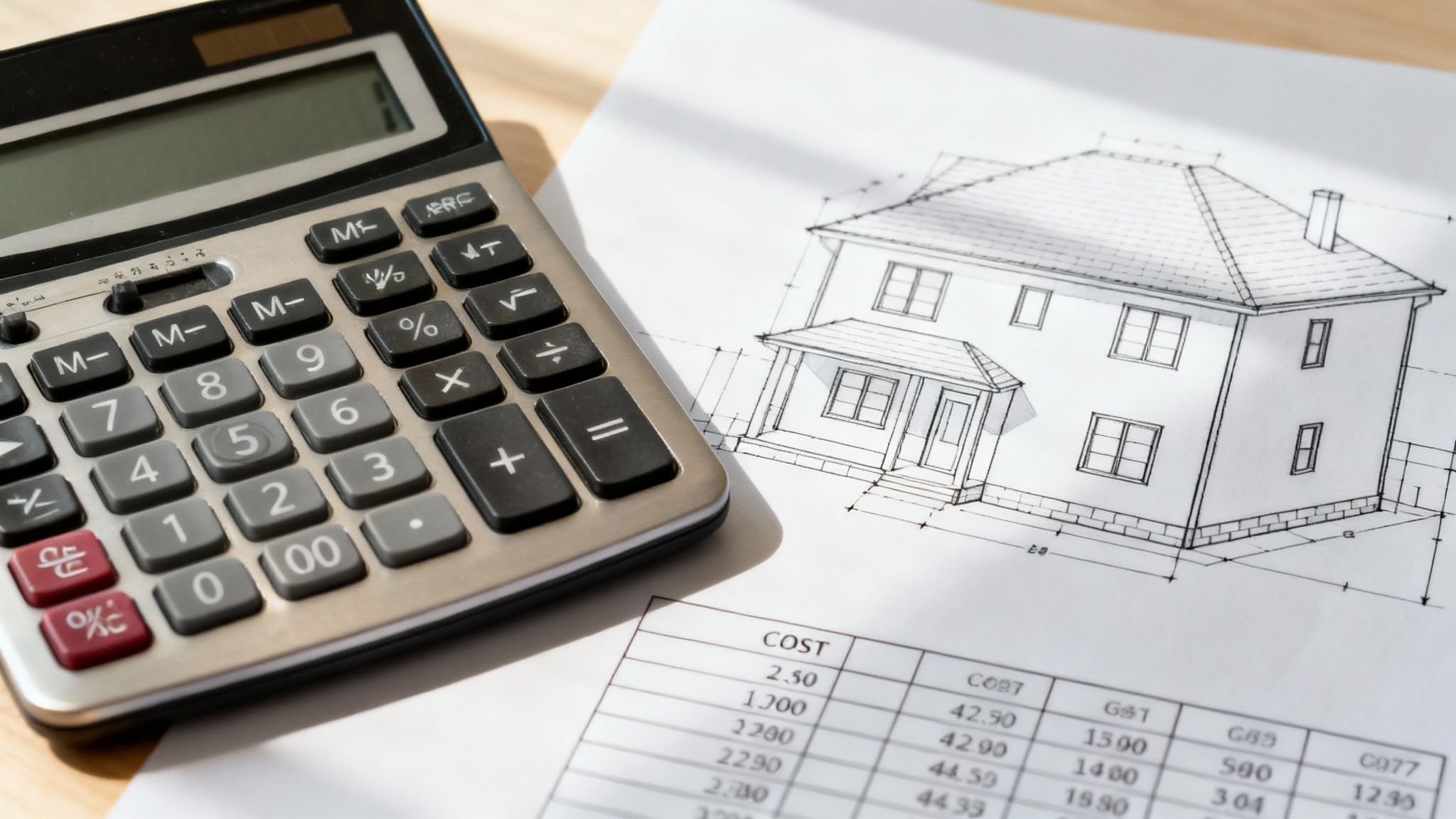Holding costs are the ongoing expenses you pay to own a real estate asset, from the moment you close the deal until the day you sell it. Think of them as the 'cost of waiting'—they cover everything from mortgage payments and property taxes to insurance and basic utilities. For savvy investors, mastering these costs is the key to protecting profits.
The Hidden Costs Draining Your Investment Returns

It’s easy for investors to get tunnel vision, focusing only on the purchase price and the potential final profit. But there's a sneaky factor that quietly eats away at your returns: holding costs.
Think of owning an investment property like having a monthly subscription. Whether you're actively using it or not, that bill shows up like clockwork every single month.
These expenses, often called carrying costs, are the relentless fees you incur just for having your name on the title, regardless of whether the property is making money or sitting empty. For any serious investor, getting a firm handle on these numbers isn't just a good idea—it's a non-negotiable part of your due diligence.
Let's break down the core concept quickly.
Holding Costs at a Glance
| Concept | Key Takeaway & Actionable Insight |
|---|---|
| Definition | The recurring expenses you pay to own a property from purchase to sale. Action: Itemize every potential cost before making an offer. |
| Core Components | Mortgage payments, taxes, insurance, utilities, HOA fees, and maintenance. Action: Get real quotes for insurance and verify tax records. |
| Primary Impact | Directly reduces your net profit, especially on fix-and-flip projects. Action: Build holding costs into your maximum allowable offer (MAO). |
| Key Variable | Time. The longer you hold the property, the more these costs accumulate. Action: Create a detailed project timeline with a buffer for delays. |
Essentially, mastering holding costs means mastering your project's timeline and budget.
The True Price of Time
Time is the single biggest variable that can make or break your bottom line. The longer you hold onto a property—especially during a fix-and-flip—the more these costs pile up, directly chipping away at your profit margin.
Imagine your renovation project takes six months. That's six months of mortgage payments, six months of property taxes, six months of insurance, and six months of utilities you have to pay before you see a single dollar in return. This is exactly why getting your timeline and budget right is so critical.
Actionable Tip: For every month of potential delay, calculate the full holding cost. If your monthly carry is $3,000, a two-month delay means your profit target must be at least $6,000 higher to break even.
And these expenses aren't just for active renovations. A vacant rental property is also racking up costs every single day it sits empty.
This is why it's so important to see the whole financial picture beyond just the initial repair budget. To get started, check out our guide on how to estimate renovation costs to build a more complete financial forecast. In the end, managing these carrying costs is what separates the seasoned pros from the beginners who get blindsided by unexpected expenses.
Breaking Down Your Holding Cost Components
Knowing that holding costs exist is the first step. The real challenge is pinning down every single expense that falls under this sneaky umbrella. To build a budget you can actually trust, you have to move beyond the general idea and create a concrete checklist of every potential cost. These are the relentless expenses that tick up day after day, whether your property is sitting empty or has tenants inside.
This breakdown gives you a clear visual of the main categories of holding costs that every savvy real estate investor needs to track.

As you can see, major expenses like property taxes, insurance, and maintenance aren't just separate line items—they're the foundational pillars of your total carrying costs. They all work together to put cumulative financial pressure on your investment.
To help you get a handle on what to expect, here’s a table outlining the most common holding costs and actionable steps for each.
Common Holding Costs and How to Plan for Them
| Cost Component | Typical Range / Calculation | Actionable Tip for Investors |
|---|---|---|
| Mortgage (P+I) | Varies based on loan amount, rate, term | Get pre-approved to know your exact monthly payment. Don't just estimate. |
| Property Taxes | 1% - 2.5% of assessed value annually | Look up the property's tax history on the county assessor's website. Don't rely on the seller's number. |
| Insurance | $1,200 - $3,500+ annually | Get at least three quotes for a landlord or vacant property policy before closing. |
| HOA Fees | $200 - $700+ monthly (for condos/townhomes) | Request the HOA's budget documents to check for upcoming special assessments that could spike your costs. |
| Utilities | $150 - $400+ monthly (when vacant) | Call utility companies for an estimate based on the property's past usage. Keep services on during vacancies. |
| Routine Maintenance | 1% of property value annually (Rule of Thumb) | Set up a separate bank account and auto-transfer this amount monthly to build your maintenance fund. |
| Property Management | 8% - 12% of monthly rent | Interview multiple property managers to compare fees and services. Ask for their vacancy and eviction rates. |
This table provides a great starting point, but always be sure to research the specific rates and costs for your local market to get the most accurate numbers for your own budget.
Core Financial Obligations
The most predictable holding costs are the ones tied to financing and legal requirements. Think of these as the non-negotiable, fixed expenses that form the baseline of your monthly budget.
- Mortgage Payments: This is usually the big one, covering both the loan principal and interest. Every single month you hold the property, another payment is due.
- Property Taxes: Local governments levy these, and they are completely unavoidable. Taxes can vary dramatically from one city to the next and represent a significant, recurring drain on your cash.
- Insurance Premiums: You absolutely need property insurance to protect your asset. A crucial point here is that insurance for a rental property is almost always more expensive than a standard homeowner's policy because it covers different risks, like liability for tenants.
Property-Specific Expenses
Beyond the core financial payments, every property has its own unique set of operational costs. These expenses can fluctuate a lot more than your mortgage, which is why you have to keep a close eye on them.
A condo in a managed building, for instance, will come with Homeowner Association (HOA) fees to cover shared amenities and maintenance. A single-family home won't have those fees, but you'll be on the hook for services like trash removal and landscaping directly.
And then you have utilities—water, electricity, gas, and internet. You have to pay for these even when the property is vacant, either to prevent problems like frozen pipes or to let your contractors get their work done. These seemingly small costs add up incredibly fast over a few months.
The real danger of holding costs isn't any single expense, but their combined, cumulative effect over time. A three-month delay on a project doesn't just mean three more mortgage payments; it means three more payments for everything.
Maintenance and Management Costs
Finally, you've got the costs tied to upkeep and oversight. Routine maintenance covers everything from fixing a leaky faucet to servicing the HVAC system. It's also incredibly wise to budget for unexpected repairs, because those are the things that can completely derail an otherwise profitable deal.
If you bring in a third party to handle the day-to-day operations, property management fees will become part of your holding costs, too. These fees are typically a percentage of the monthly rent. Getting a firm grip on all these components is fundamental, and you can dig deeper into the essential real estate math formulas that help you project these expenses with accuracy.
How to Calculate Real Estate Holding Costs

Putting numbers to your holding costs transforms guesswork into a clear financial picture. It isn’t just piling invoices—it’s mapping every expense across your entire hold period to know exactly what you’ll owe.
At its simplest, you tally every monthly cost to get your Total Monthly Holding Cost. Then multiply that by the number of months you plan to own the property.
Formula: Total Holding Costs = (Sum of All Monthly Expenses) x (Number of Months Held)
That one line unlocks the true cost of ownership. Let’s walk through two scenarios to see how the math plays out.
Scenario 1: Fix-And-Flip Project
Imagine buying a distressed home, renovating it, and selling in four months. With no rental income, all expenses come directly from your wallet.
Monthly Costs Breakdown:
- Mortgage Payment: $2,100
- Property Taxes: $350 (or $4,200 annually ÷ 12)
- Insurance: $150 (vacancy rates bump this up)
- Basic Utilities (Water/Electric): $200
- Lawn Care & Maintenance: $100
Total Monthly Holding Cost:$2,900
Over four months, you’d incur $2,900 × 4 = $11,600 in carrying costs. That figure must fit into your profit margin before you even factor in renovation expenses. Hit a two-month delay? Add another $5,800 to the tab. To model these numbers on the fly, try our fix-and-flip calculator.
Scenario 2: Buy-And-Hold Rental Property
Now picture a long-term rental. Your goal is for rent to cover expenses and still deliver positive cash flow. You’ll see similar line items, but now there’s management and potential vacancy to include.
Monthly Budget Example:
- Mortgage Payment: $1,800
- Property Taxes: $300
- Insurance: $125
- HOA Fees: $250
- Property Management Fee (10% of $2,800 rent): $280
- Maintenance Fund (5% of rent): $140
Total Monthly Holding Cost:$2,895
With rent at $2,800, you’d run a $95 monthly shortfall. That gap tells you exactly where to adjust—raise rent, trim costs, or negotiate better financing. Bottom line: mastering your holding costs is the cornerstone of any profitable real estate strategy.
How Holding Costs Shape Your Investment Strategy
Knowing how to calculate holding costs is one thing. Truly understanding their power to shape your entire investment strategy is another game entirely.
These aren't just passive expenses on a spreadsheet. Think of them as the metronome setting the pace for your project. They directly influence your decisions, your risk level, and your ultimate shot at making a profit. Different investment models feel the heat from these costs in very different ways.
The Fix-and-Flip Pressure Cooker
For a fix-and-flipper, time is the absolute enemy. Every single day you own that property, holding costs are actively eating away at your future profits. It's a constant drain.
A project that looks like a home run on a four-month timeline can quickly turn into a strikeout if unexpected delays push it to six or seven months. The pressure to finish renovations, get it listed, and find a buyer becomes immense.
The longer you hold a flip, the thinner your profit margin gets. Holding costs create a direct, inverse relationship between your timeline and your return on investment.
This reality forces flippers to obsess over speed and efficiency. You have to master project management, line up reliable contractors, and price the property competitively from day one just to minimize the time that holding costs have to bleed you dry.
The Slow Burn for Long-Term Investors
For buy-and-hold investors, the dynamic is different, but the stakes are just as high. A quick sale isn't the goal, but your holding costs are a vital sign of your property's financial health.
They directly hammer two of the most important metrics for any rental property: cash flow and Net Operating Income (NOI).
Think of it this way: your monthly holding costs are the hurdle your rental income has to clear. If your carrying costs are higher than the rent you bring in, you have negative cash flow—you're literally paying out of pocket to own the asset each month. This is why accurately projecting every expense—from taxes and insurance to a healthy maintenance fund—is non-negotiable before you ever make an offer.
A Powerful Lesson from the Past
The real-world gut punch of underestimating these costs is never clearer than when the market turns. If you want a history lesson, look no further than the U.S. housing bubble burst of 2007-2008. Holding costs were a deciding factor in countless foreclosures and investor wipeouts.
Investors found themselves with underwater mortgages, unable to sell or even lease their properties for enough to cover the bills. During this meltdown, median carrying costs—including taxes, insurance, utilities, and loan payments—crept up to 3% to 5% of the property's value every month in some hard-hit markets.
That immense financial pressure is what ultimately pushed so many over the edge. It was a stark reminder that the purchase price is only the beginning; the inability to cover the ongoing cost of ownership is what can truly sink you. You can get a better sense of how these carry costs influenced the market by exploring some in-depth financial glossaries. That chapter in history proves that managing your holding costs isn't just good business—it's fundamental to surviving any market cycle.
Actionable Strategies to Reduce Your Holding Costs

Knowing your holding costs is one thing, but actively crushing them is how you get ahead in this business. These aren't fixed, unchangeable numbers. With the right strategy, you can find and plug the financial leaks that drain your profits.
Think of your investment property like a high-performance engine. A few smart tweaks here and there can lead to massive gains in efficiency and, more importantly, put more money back in your pocket. Here’s a playbook for trimming those costs and boosting your bottom line.
Refine Your Core Financial Obligations
Your biggest monthly checks—mortgage, taxes, and insurance—are often where the biggest savings are hiding in plain sight.
Shop for Better Insurance Rates: Never just accept the first quote you get. Insurance premiums can vary wildly between providers, so make it a yearly ritual to shop around. A few phone calls could save you hundreds, if not thousands, annually.
Appeal Your Property Tax Assessment: Taxes are a huge piece of what is a holding cost in real estate. If you think the county's valuation of your property is too high, you have every right to appeal it. A successful appeal directly lowers your tax bill and can be a game-changer for your cash flow.
Consider Refinancing Your Mortgage: If interest rates have dropped since you bought the place, refinancing is a no-brainer. This is especially true for buy-and-hold investors where even a small reduction in your monthly payment adds up to significant savings over the life of the loan.
The most impactful cost-saving moves come from challenging the big expenses most investors just accept as reality. A single successful tax appeal or finding a better insurance broker pays you back year after year.
Optimize Property Operations and Maintenance
Beyond the big three, the day-to-day costs of running a property can add up fast. Smart operational management is key to stopping the slow bleed.
Making a few strategic upgrades can slash your utility bills. Think about installing LED lighting, a smart thermostat, or adding more insulation. These small upfront investments pay for themselves over and over by cutting down what you or your tenants owe the power company each month.
And remember, proactive maintenance is always cheaper than emergency repairs. Regularly servicing the HVAC, checking for small plumbing leaks, and fixing minor issues before they explode will save you from those heart-stopping, budget-destroying phone calls from contractors on a holiday weekend.
For Flippers: Shorten Your Holding Period
If you’re in the fix-and-flip game, your most powerful weapon against holding costs is speed. Every single day you own that property, it's costing you money. The clock is your enemy.
Create a Detailed Renovation Plan: Have your entire scope of work, budget, and timeline locked in before you even close. Your contractors should be lined up and ready to start the second you get the keys.
Order Materials in Advance: Nothing kills a timeline like waiting weeks for cabinets or windows to arrive. Order any materials with long lead times the moment you know you're moving forward.
Price for a Quick Sale: As soon as the renovation is done, get it on the market and price it to move. Holding out for an extra few thousand dollars could easily be wiped out by another month of mortgage, tax, and utility payments.
Common Questions About Holding Costs
Once you start wrapping your head around holding costs, a bunch of practical questions always pop up. Let's tackle some of the most common ones I hear from investors to give you more confidence in planning your next move. We'll cover some useful rules of thumb, the big differences between residential and commercial properties, and how to steel yourself against the unexpected.
What Is a Good Rule of Thumb for Estimating Holding Costs?
While every deal is different, investors love a good shortcut to get started. For routine maintenance and small repairs, the 1% Rule is a classic. The idea is to budget at least 1% of the property's purchase price each year for general upkeep.
So, for a $300,000 house, you'd plan for $3,000 a year, which breaks down to about $250 a month.
But remember, that only covers one piece of the puzzle. For a more complete picture of your total holding costs (not including your mortgage), a better guideline is to budget between 25% and 40% of your gross rental income. This wider range is designed to account for property taxes, insurance, and potential vacancy—not just maintenance.
A "rule of thumb" is a fantastic starting point, but it should never replace detailed, local research. Always get actual quotes for taxes and insurance in your specific market to build a truly reliable budget.
How Do Holding Costs Differ for Residential and Commercial Properties?
The basic ingredients of holding costs are the same for both residential and commercial real estate, but the scale and complexity can be worlds apart.
- Residential Properties: These are usually more straightforward. You’ll have predictable expenses like HOA fees, standard property insurance, and basic utilities. Maintenance typically centers on individual living systems like plumbing and HVAC units.
- Commercial Properties: Here, the stakes are often much higher. Insurance premiums can be massive due to greater liability risks, and property taxes are frequently assessed at a higher commercial rate. Maintenance can get complicated fast, involving things like industrial-grade elevators, complex fire suppression systems, and massive parking lots.
On top of that, many commercial leases (like triple net or NNN leases) are structured to pass the responsibility for taxes, insurance, and maintenance directly to the tenant. This can completely change the landlord's holding cost structure.
Are Holding Costs Tax-Deductible for Real Estate Investors?
Yes, and this is one of the biggest financial perks of owning investment real estate. For investors, most holding costs are considered ordinary business expenses and are generally tax-Deductible.
This means you can typically write off expenses like:
- Mortgage interest (but not the principal payment)
- Property taxes
- Insurance premiums
- Utilities
- Repairs and maintenance costs
- Property management fees
These deductions directly lower your taxable income, which reduces how much you owe the IRS. The key is to keep meticulous records of every single penny you spend. Always talk to a qualified tax professional to make sure you're following the law and getting every deduction you're entitled to.
How Can I Budget for Unexpected Holding Costs?
Big, nasty surprises—like a roof that suddenly starts leaking or an HVAC system that dies in the middle of summer—can blow up an otherwise great investment. The best defense is a good offense: a dedicated capital expenditures (CapEx) fund.
Think of this as a separate savings account where you consistently stash cash for those major, infrequent repairs and replacements. A common strategy is to set aside 5% to 10% of your monthly gross rent for this fund. By building up this reserve, you ensure you have the money ready to handle emergencies without sinking into debt or wrecking your cash flow.
Ready to stop guessing and start analyzing properties with precision? Flip Smart gives you the power to calculate valuations, estimate renovation costs, and project profit potential in seconds. Make your next investment decision with data, not doubt. Analyze your first property for free on flipsmrt.com.
